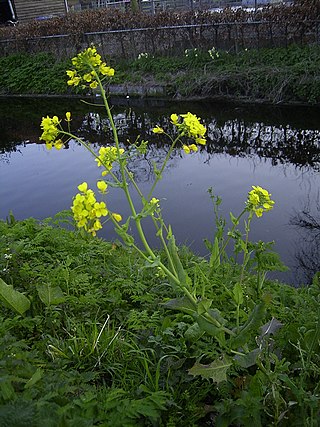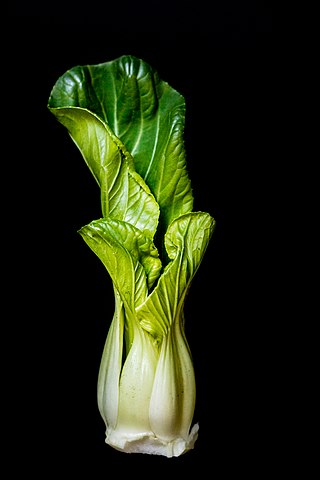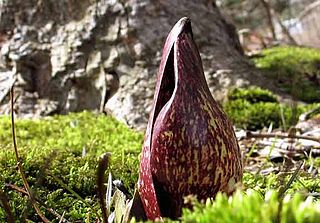
Bubble and squeak is a British dish made from cooked potatoes and cabbage, mixed together and fried. The food writer Howard Hillman classes it as one of the "great peasant dishes of the world". The dish has been known since at least the 18th century, and in its early versions it contained cooked beef; by the mid-20th century the two vegetables had become the principal ingredients.

Cabbage, comprising several cultivars of Brassica oleracea, is a leafy green, red (purple), or white biennial plant grown as an annual vegetable crop for its dense-leaved heads. It is descended from the wild cabbage, and belongs to the "cole crops" or brassicas, meaning it is closely related to broccoli and cauliflower ; Brussels sprouts ; and Savoy cabbage.

Cabbage Patch Kids are a line of cloth dolls with plastic heads first produced by Coleco Industries in 1982. They were inspired by the Little People soft sculptured dolls sold by Xavier Roberts as collectibles. The brand was renamed 'Cabbage Patch Kids' by Roger L. Schlaifer when he acquired the exclusive worldwide licensing rights in 1982.

Brassica is a genus of plants in the cabbage and mustard family (Brassicaceae). The members of the genus are informally known as cruciferous vegetables, cabbages, mustard plants, or simply brassicas. Crops from this genus are sometimes called cole crops—derived from the Latin caulis, denoting the stem or stalk of a plant.

Sauerkraut is finely cut raw cabbage that has been fermented by various lactic acid bacteria. It has a long shelf life and a distinctive sour flavor, both of which result from the lactic acid formed when the bacteria ferment the sugars in the cabbage leaves.

Guerrilla art is a street art movement that first emerged in the UK, but has since spread around the world and is now established in most countries that already had developed graffiti scenes. In fact, it owes so much to the early graffiti movement, in the United States guerrilla art is still referred to as 'post-graffiti art'.

Kale, also called leaf cabbage, belongs to a group of cabbage cultivars primarily grown for their edible leaves. It has also been used as an ornamental plant.

Bok choy, pak choi or pok choi is a type of Chinese cabbage, used as food. Chinensis varieties do not form heads and have green leaf blades with lighter bulbous bottoms instead, forming a cluster reminiscent of mustard greens. It has a flavor between spinach and water chestnuts but is slightly sweeter, with a mildly peppery undertone. The green leaves have a stronger flavor than the white bulb.

Coleslaw, also known as cole slaw or simply as slaw, is a side dish consisting primarily of finely shredded raw cabbage with a salad dressing or condiment, commonly either vinaigrette or mayonnaise. This dish originated in the Netherlands in the 18th century. Coleslaw prepared with vinaigrette may benefit from the long lifespan granted by pickling.

A cabbage roll is a dish consisting of cooked cabbage leaves wrapped around a variety of fillings. It is common to the cuisines of Central, Northern, Eastern and Southeastern Europe and much of Western Asia, Northern China, as well as parts of North Africa. Meat fillings are traditional in Europe, and include beef, lamb, or pork seasoned with garlic, onion, and spices. Grains such as rice and barley, mushrooms, and vegetables are often included as well. Fermented cabbage leaves are used for wrapping, particularly in southeastern Europe. In Asia, seafoods, tofu, and shiitake mushrooms may also be used. Chinese cabbage is often used as a wrapping.

Symplocarpus foetidus, commonly known as skunk cabbage or eastern skunk cabbage, is a low-growing plant that grows in wetlands and moist hill slopes of eastern North America. Bruised leaves present an odor reminiscent of skunk.

Livistona australis, the cabbage-tree palm, is an Australian plant species in the family Arecaceae. It is a tall, slender palm growing up to about 25 m in height and 0.35 m diameter. It is crowned with dark, glossy green leaves on petioles 2 m long. It has leaves plaited like a fan; the terminal bud of these is small but sweet. In summer it bears flower spikes with sprigs of cream-white flowers. The trees accumulate dead fronds or leaves, which when the plant is in cultivation are often removed by an arborist.

Cheese slaw is a side dish consisting of cheddar cheese, carrot, mayonnaise, and sometimes cabbage. Other cheeses such as blue and Swiss are occasionally used in its preparation, and additional vegetable ingredients are sometimes used. Its origins can be traced to Townsville in north Queensland, Australia, and to Broken Hill, New South Wales, Australia. It is a common and popular dish in Broken Hill restaurants and households. Cheese slaw is also consumed in some areas of the United States.

Napa cabbage is a type of Chinese cabbage originating near the Beijing region of China that is widely used in East Asian cuisine. Since the 20th century, it has also become a widespread crop in Europe, the Americas, and Australia. In much of the world, it is referred to as "Chinese cabbage". In Australia, it is sometimes referred to as "wombok".

Crocidolomia pavonana is a moth of the family Crambidae. Its caterpillar is a crop pest and is known as the croci or the cabbage cluster caterpillar. This moth is found in Africa and Asia, its range extending from South Africa through India to the Pacific Ocean, including Australia. The wingspan is about 25 mm (1 in). The larvae feed on Brassicaceae species and are considered an agricultural pest on cabbages. The species was first described by Johan Christian Fabricius in 1794.

Cabbage Tree Island, also known as the John Gould Nature Reserve, is a protected nature reserve and uninhabited continental island lying 1.4 km (0.87 mi) off the mouth of Port Stephens on the coast of New South Wales, Australia. The 30-hectare (74-acre) reserve and island is named for the cabbage-tree palms in the two gullies on the island's western side which are the nesting site of Goulds petrel. It is the principal breeding site of the threatened nominate subspecies of the Gould's petrel and, with the nearby Boondelbah Island where there is also a small colony, has been classified by BirdLife International as an Important Bird Area.

A cabbage tree hat is a hat made from the leaves of the Livistona australis, also known as the cabbage-tree palm. It is known as the first distinctively Australian headwear in use. Seeking protection from the sun, early European settlers started to make hats using fibre from the native palm, which soon became popular throughout the colonies. The process involved boiling, then drying, and finally bleaching the leaves. The Powerhouse Museum describes a cabbage-tree hat thus: "Finely woven natural straw coloured hat; high tapering domed crown, wide flat brim; applied layered hat band of coarser plaiting with zig-zag border edges."
Samoan Sign Language is the deaf sign language of Samoa.

Steiglitz is a rural coastal town and locality in the City of Gold Coast, Queensland, Australia. In the 2021 census, the locality of Steiglitz had a population of 682 people.
Cabbage Tree Island is a locality in Ballina Shire located in the Northern Rivers Region of New South Wales. It is a mostly Aboriginal community.




















